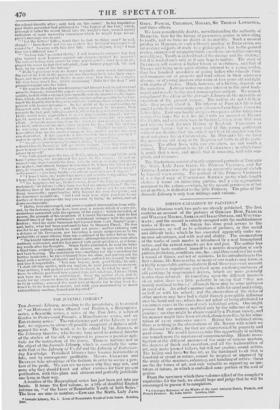SMITH'S CATALOGUE OF PAINTERS"
OF this laborious work two parts are already published. The first contains an account of the pictures of GERARD Dow, FRANCIS and WILLIAM MIERIS, ADRIAN and ISAAC OSTADE, and WO UVER- MANS ; and the second is entirely occupied with the multitudinous works of ItunEss. Mr. SMITH has done good service to the connoisseurs, as well as to collectors of pictures, in this useful and difficult task ; which he has executed apparently under nu- merous advantages, and with zeal and ability. The enumeration of the works of each master is introduced by a neat biographical notice, and the critical remarks are few and just. The author has with good taste confined himself to a minute description of each picture, its history, condition, size, &c. ; and thus rendered his work a record of things, and not of' opinions. In his introduction to the first volume, Mr. Ssirrn (who, as many of our readers may know, is a highly respeet able picture-dealer in Bond Street) gives an account of the various impositions practised upon amateur-pm-chasers of old paintings by unprincipled dealers, which are more generally known flout detected. In remarking upon the different manners of an artist, there is a little pedantry in saying that " they are usually confined to three ;" although there may be sonic instances in proof of it. An artist's manner varies with his mind and feeling, as well as with his school; and the observation of the styles of other masters may have had a slight though perceptible influence over his hand and eye, which does not admit or being attributed to a common cause in the ease of each individual artist. One might possess but one manner, modified only by the influence of age or practice ; another might be charact erized by a Protean variety, and his manner mi.r1 it have been affected, chameleon-like, by his admi- ration or every successive master. Bating this technical error, there is nothing in the observations of Mr. SMITH with which we are disposed to differ ; for they are characterized by propriety and good sense. We would, howev em-, take this opportunity of making one remark upon the mysteries of connoisseurship. Minute inves- tigation of the different manners of the same or various masters, the degrees of finish and execution, and all the technicalities of art, may make learned talkers, but will not produce sound critics. The feeling and taste for fine art, as the handmaid to all that is beautiful or grand in nature, cannot be inspired or improved by the study of the manners, colouring, and handling of artists : these are the dry- bones of art, and only valuable as supporting an imi- tation of nature, in which is embodied some portion of the soul of genius.
From the specimen which these volumes afford of the compiler's capabilities for the task, we should hope and judge that he will be encouraged to pursue it to completion.
*A Catalogue Raisonn6 of the Works of' the most eminent Dutch, Flemish, and French Painters. By John Smith, London, 1630.


























 Previous page
Previous page